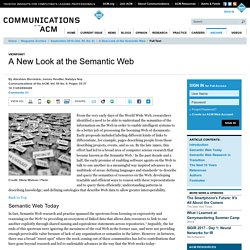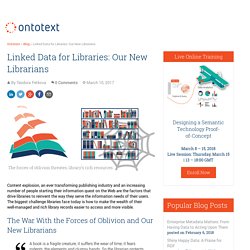

*A New Look at the Semantic Web (Skim) By Abraham Bernstein, James Hendler, Natalya Noy Communications of the ACM, Vol. 59 No. 9, Pages 35-37 10.1145/2890489 Comments (1) From the very early days of the World Wide Web, researchers identified a need to be able to understand the semantics of the information on the Web in order to enable intelligent systems to do a better job of processing the booming Web of documents.

Early proposals included labeling different kinds of links to differentiate, for example, pages describing people from those describing projects, events, and so on. Back to Top Semantic Web Today The list goes on. Semantic Web Research in Transition As the early research has transitioned into these larger, more applied systems, today's Semantic Web research is changing: It builds on the earlier foundations but it has generated a more diverse set of pursuits. As the early research has transitioned into larger, more applied systems, today's Semantic Web research is changing. The Next 10 Years References 1. 2. 3. 4. 5. ConceptNet. Linked Data for Libraries: Our New Librarians.
Content explosion, an ever transforming publishing industry and an increasing number of people starting their information quest on the Web are the factors that drive libraries to reinvent the way they serve the information needs of their users.

The biggest challenge libraries face today is how to make the wealth of their well-managed and rich library records easier to access and more visible. The War With the Forces of Oblivion and Our New Librarians A book is a fragile creature, it suffers the wear of time, it fears rodents, the elements and clumsy hands. So the librarian protects the books not only against mankind but also against nature and devotes his life to this war with the forces of oblivion. Cit. In the digital world of constant connectivity, the main forces of oblivion translate into lack of visibility and poor information retrieval techniques. For that to happen, library data need to be structured, well-connected and easy to access, use and reuse.
Visibility with Benefits Cit. *Scientific American Feature Article The Semantic Web May 2001 (skim) Tim Berners-Lee: The next Web of open, linked data. *Jimmy Wales on the Semantic Web. Intro to the Semantic Web. What is Linked Data? GoodRelations: The Professional Web Vocabulary for E-Commerce. *What is Google’s Knowledge Graph? Google’s Knowledge Graph is hard to find, but its results are not.

Take for instance that big block of information that appears on the right-hand side of your desktop screen after entering a search term. This block – also known as the Knowledge Graph Card – contains relevant, context-specific information regarding your search, powered by the Knowledge Graph. If you search for a specific company, the Knowledge Graph will show an almost complete profile, depending on how well they did their SEO work. Searching for a recently released movie will show posters, reviews and screening times for your local cinema.
As you see, the graph is a powerful and fascinating tool. It’s Google’s way of connecting information Google’s core business is providing people with a correct answer to all their questions. The Knowledge Graph and its card This is where it might get confusing: many people mix up the Knowledge Graph and the panel you see on the right-hand side of your screen. Examples of search results. Schema.org. About Linked Jazz. Semantic Web vs. Web 2.0 (an old, but fun representation by students)